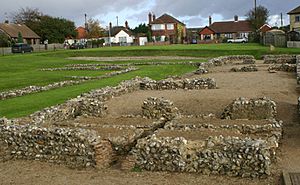Caister-on-Sea facts for kids
Quick facts for kids Caister-on-Sea |
|
|---|---|
| Population | 8,901 (2011 Census) |
| OS grid reference | TG512125 |
| District |
|
| Shire county | |
| Region | |
| Country | England |
| Sovereign state | United Kingdom |
| Post town | GREAT YARMOUTH |
| Postcode district | NR30 |
| Dialling code | 01493 |
| Police | Norfolk |
| Fire | Norfolk |
| Ambulance | East of England |
| EU Parliament | East of England |
| UK Parliament |
|
Caister-on-Sea, often just called Caister, is a large village and a fun seaside resort in Norfolk, England. It's located just north of the town of Great Yarmouth. In 2011, about 8,901 people lived there.
Caister used to have its own train station, but it closed in 1959. Now, the closest train station is in Great Yarmouth, about 4 kilometers (2.5 miles) south.
Off the coast, you can see the Scroby Sands wind farm. It has thirty big wind turbines, each making 2 megawatts of power. They are about 2.5 kilometers (1.5 miles) offshore.
Caister Castle is a cool 15th-century tower with a car museum nearby. It's about 2 kilometers (1.2 miles) to the west of the village.
Contents
Discover Caister's Past: Roman Times to Today
Caister-on-Sea has a very long and interesting history! It goes all the way back to the time of the Romans.
Roman Fort: A Military Base in Caister
Around the year AD 200, the Romans built a fort here. It was a base for their army and navy. Later, another fort was built at Burgh Castle on the other side of the river. This meant the Caister fort became less important.
The name "Caister" actually comes from an old Anglo-Saxon word, "ceaster." This word means "Roman fort," which tells us a lot about the village's origins!
In the 1950s, people dug up some old Roman buildings near Caister. These buildings didn't seem to be for soldiers. They had special heating systems and painted walls. They even found women's jewelry! This suggests it might have been an officer's house. The Roman site was left empty around the 5th century. However, about 150 Saxon burials were found nearby. Today, you can visit the Caister Roman Site for free. It's managed by English Heritage.
The Brave Caister Lifeboat Crew
People in Caister have been helping ships in trouble at sea since 1791. A special boat called a lifeboat was used to rescue people from shipwrecks on the sandbanks.
From 1856 to 1969, the RNLI operated the lifeboats. A very sad event happened in 1901, known as the 1901 Caister lifeboat disaster. Nine brave crew members lost their lives trying to save a ship during a big storm.
After this tragedy, people said, "If they had to keep at it 'til now, they would have sailed about until daylight to help her. Going back is against the rules when we see distress signals like that." This led to the famous saying, "Caister men never turn back."
A monument honoring these lost men stands in the village cemetery. It was put up in 1903. There's even a pub called the "Never Turn Back" named after this brave saying!
Today, Caister also has a National Coastwatch Institution (NCI) Station. This group helps keep an eye on the coast and sea.
Caister Today: Holidays and Fun
Caister-on-Sea is a popular place for holidays!
Holiday Parks and Fun Activities
There's a big Haven caravan and holiday park near the coast. This park has a long history. It started way back in 1906 as the "Caister Socialist Camp." It's one of the oldest holiday camps in the United Kingdom!
In the 1950s and early 1960s, the holiday camp was on both sides of the road. One side had a dining room, shops, and sports areas. These parts were later sold and turned into houses. In the 1980s, a new holiday camp opened.
Local Sports: Caister Football Club
Caister also has its own football team, called Caister FC. They play their games at the King George V playing field.

See also
 In Spanish: Caister-on-Sea para niños
In Spanish: Caister-on-Sea para niños


